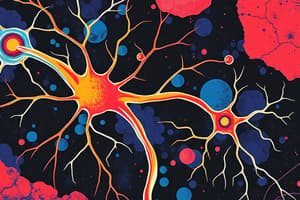Podcast
Questions and Answers
What does reflex sensitivity depend on?
What does reflex sensitivity depend on?
- The strength of muscle contraction
- The orientation of the body
- The duration of the reflex arc
- The amount of stretch encountered (correct)
Which factors influence reflex amplitude in response to perturbations?
Which factors influence reflex amplitude in response to perturbations?
- The amount of ongoing muscle activity (correct)
- Type of sensory input received
- Muscle fiber type composition
- Speed of the reflex arc
What is implied by the term ‘preparatory set’ in motor responses?
What is implied by the term ‘preparatory set’ in motor responses?
- The ability to adapt to unexpected outcomes
- The concentration of muscle enzymes available
- The readiness of the motor system to generate a desired action or response (correct)
- The training history of the individual
In complex 3D situations, how do reflexes adapt to non-symmetric stability?
In complex 3D situations, how do reflexes adapt to non-symmetric stability?
What is the conclusion regarding reflex responses in complex stability situations?
What is the conclusion regarding reflex responses in complex stability situations?
What is the primary function of excitatory interneurons in the withdrawal reflex?
What is the primary function of excitatory interneurons in the withdrawal reflex?
What characterizes the crossed extensor reflex compared to the withdrawal reflex?
What characterizes the crossed extensor reflex compared to the withdrawal reflex?
How do transcortical stretch reflexes differ from spinal stretch reflexes?
How do transcortical stretch reflexes differ from spinal stretch reflexes?
What is a potential effect of abnormalities in reflex actions?
What is a potential effect of abnormalities in reflex actions?
Which factor is crucial in determining how reflexes are expressed in different movement contexts?
Which factor is crucial in determining how reflexes are expressed in different movement contexts?
Flashcards are hidden until you start studying
Study Notes
Types of Movement
- Spinal reflexes are circuits underlying fast responses to afferent stimuli.
- Automatic behaviours are more complex reactions to afferent stimuli involving more complex circuits.
- Voluntary actions are generated by the cerebral cortex.
Withdrawal Reflex
- Initiated by activation of nociceptors (pain receptors).
- Afferent impulses are transmitted to an excitatory interneuron in the spinal cord.
- Motor neurons of flexor muscles are activated.
- Motor neurons of extensor muscles are inhibited.
Crossed Extensor Reflex
- Initiated by the same stimulus that generates a withdrawal reflex.
- Excitatory interneurons activate motor neurons projecting to extensor muscles of the opposite limb.
- Flexor muscles of the opposite limb are inhibited.
- Limb opposite painful stimulus extends.
Transcortical Stretch Reflexes
- Signals from stretch receptors are transmitted to the sensorimotor cortex.
- A motor response is transmitted via the corticospinal tract to the same muscle as the spinal stretch reflex.
- Can be observed in both arms.
Reflex Sensitivity in Complex 3D Situations
- Reflexes are capable of smart responses that act to maximise postural stability, even in complex 3D situations.
- Reflex amplitude changes depending on the amount of ongoing muscle activity, the direction of the perturbation, and the direction of instability provided.
Preparatory Set
- Increases the excitability of task-relevant neural circuits prior to action.
Changes in Co-Contraction to Balance
- Co-contraction levels and stretch reflex sensitivity increase as stability is reduced.
Automatic Postural Reactions
- Three coordinative strategies used to correct standing posture: ankle, knee, and stepping.
Reactive Postural Control Strategies
- Involve complex patterns of muscle activity.
- Occur too late to be reflexive.
- Likely generated in the brainstem.
Anticipatory Postural Adjustments (APAs)
- Used to anticipate perturbations caused by self-movement to enable us to move limbs independently of the body.
Reflex Inhibition During Voluntary Actions
- Descending input to ankle dorsiflexors reduces the size of stretch reflexes generated in plantarflexors.
Spasticity
- Involuntary increase in muscle tone, leading to resistance against normal movements of the body and pain.
Reflex Roles in Spasticity
- Reduced input from motor centres in the brain to spinal motor neurons.
- Normal inhibition of stretch reflexes reduced.
- Stretch reflex becomes hyper-reactive.
- Produces a force resisting movement that is velocity-dependent.
Studying That Suits You
Use AI to generate personalized quizzes and flashcards to suit your learning preferences.




